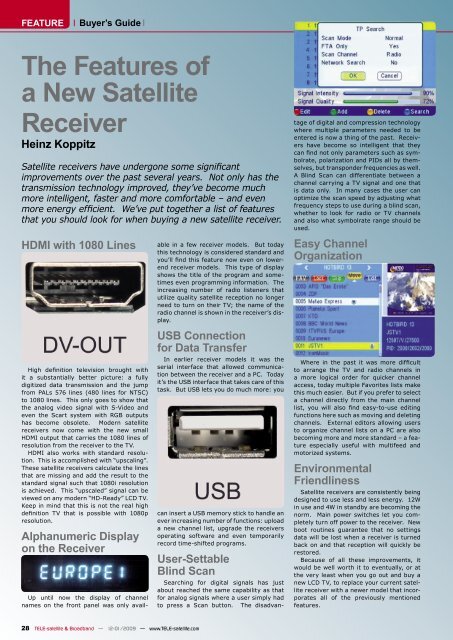_default _116_pages.indd - TELE-satellite International Magazine
_default _116_pages.indd - TELE-satellite International Magazine
_default _116_pages.indd - TELE-satellite International Magazine
Create successful ePaper yourself
Turn your PDF publications into a flip-book with our unique Google optimized e-Paper software.
FEATURE<br />
Buyer’s Guide<br />
The Features of<br />
a New Satellite<br />
Receiver<br />
Heinz Koppitz<br />
Satellite receivers have undergone some significant<br />
improvements over the past several years. Not only has the<br />
transmission technology improved, they’ve become much<br />
more intelligent, faster and more comfortable – and even<br />
more energy efficient. We’ve put together a list of features<br />
that you should look for when buying a new <strong>satellite</strong> receiver.<br />
HDMI with 1080 Lines<br />
High definition television brought with<br />
it a substantially better picture: a fully<br />
digitized data transmission and the jump<br />
from PALs 576 lines (480 lines for NTSC)<br />
to 1080 lines. This only goes to show that<br />
the analog video signal with S-Video and<br />
even the Scart system with RGB outputs<br />
has become obsolete. Modern <strong>satellite</strong><br />
receivers now come with the new small<br />
HDMI output that carries the 1080 lines of<br />
resolution from the receiver to the TV.<br />
HDMI also works with standard resolution.<br />
This is accomplished with “upscaling”.<br />
These <strong>satellite</strong> receivers calculate the lines<br />
that are missing and add the result to the<br />
standard signal such that 1080i resolution<br />
is achieved. This “upscaled” signal can be<br />
viewed on any modern “HD-Ready” LCD TV.<br />
Keep in mind that this is not the real high<br />
definition TV that is possible with 1080p<br />
resolution.<br />
Alphanumeric Display<br />
on the Receiver<br />
Up until now the display of channel<br />
names on the front panel was only avail-<br />
28 <strong>TELE</strong>-<strong>satellite</strong> & Broadband — 12-01/2009 — www.<strong>TELE</strong>-<strong>satellite</strong>.com<br />
able in a few receiver models. But today<br />
this technology is considered standard and<br />
you’ll find this feature now even on lowerend<br />
receiver models. This type of display<br />
shows the title of the program and sometimes<br />
even programming information. The<br />
increasing number of radio listeners that<br />
utilize quality <strong>satellite</strong> reception no longer<br />
need to turn on their TV; the name of the<br />
radio channel is shown in the receiver’s display.<br />
USB Connection<br />
for Data Transfer<br />
In earlier receiver models it was the<br />
serial interface that allowed communication<br />
between the receiver and a PC. Today<br />
it’s the USB interface that takes care of this<br />
task. But USB lets you do much more: you<br />
can insert a USB memory stick to handle an<br />
ever increasing number of functions: upload<br />
a new channel list, upgrade the receivers<br />
operating software and even temporarily<br />
record time-shifted programs.<br />
User-Settable<br />
Blind Scan<br />
Searching for digital signals has just<br />
about reached the same capability as that<br />
for analog signals where a user simply had<br />
to press a Scan button. The disadvan-<br />
tage of digital and compression technology<br />
where multiple parameters needed to be<br />
entered is now a thing of the past. Receivers<br />
have become so intelligent that they<br />
can find not only parameters such as symbolrate,<br />
polarization and PIDs all by themselves,<br />
but transponder frequencies as well.<br />
A Blind Scan can differentiate between a<br />
channel carrying a TV signal and one that<br />
is data only. In many cases the user can<br />
optimize the scan speed by adjusting what<br />
frequency steps to use during a blind scan,<br />
whether to look for radio or TV channels<br />
and also what symbolrate range should be<br />
used.<br />
Easy Channel<br />
Organization<br />
Where in the past it was more difficult<br />
to arrange the TV and radio channels in<br />
a more logical order for quicker channel<br />
access, today multiple Favorites lists make<br />
this much easier. But if you prefer to select<br />
a channel directly from the main channel<br />
list, you will also find easy-to-use editing<br />
functions here such as moving and deleting<br />
channels. External editors allowing users<br />
to organize channel lists on a PC are also<br />
becoming more and more standard – a feature<br />
especially useful with multifeed and<br />
motorized systems.<br />
Environmental<br />
Friendliness<br />
Satellite receivers are consistently being<br />
designed to use less and less energy. 12W<br />
in use and 4W in standby are becoming the<br />
norm. Main power switches let you completely<br />
turn off power to the receiver. New<br />
boot routines guarantee that no settings<br />
data will be lost when a receiver is turned<br />
back on and that reception will quickly be<br />
restored.<br />
Because of all these improvements, it<br />
would be well worth it to eventually, or at<br />
the very least when you go out and buy a<br />
new LCD TV, to replace your current <strong>satellite</strong><br />
receiver with a newer model that incorporates<br />
all of the previously mentioned<br />
features.

















